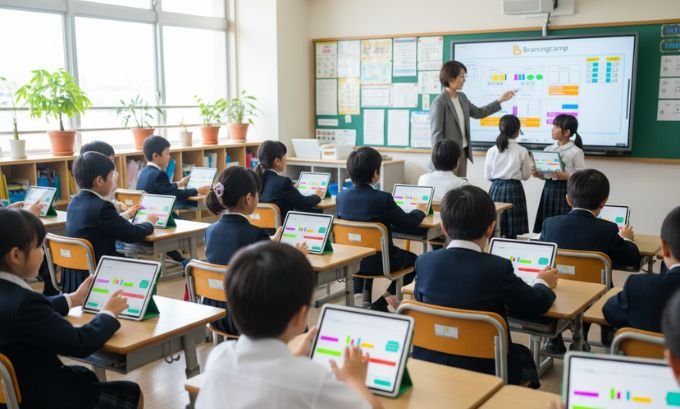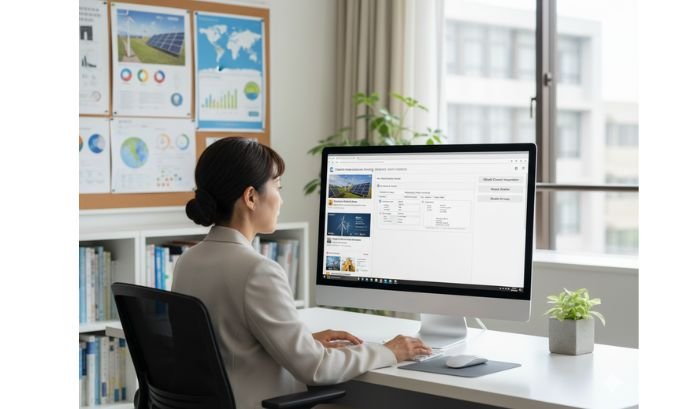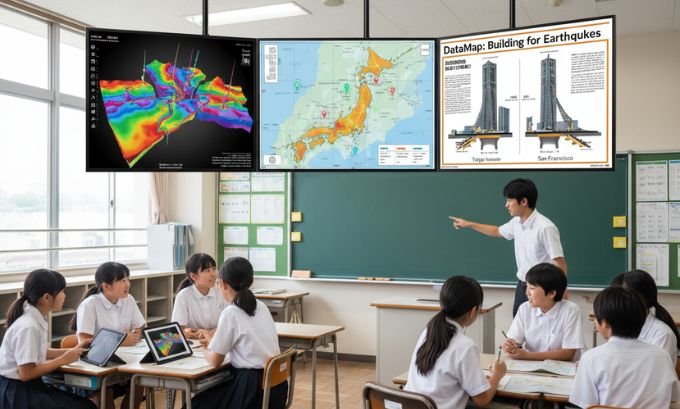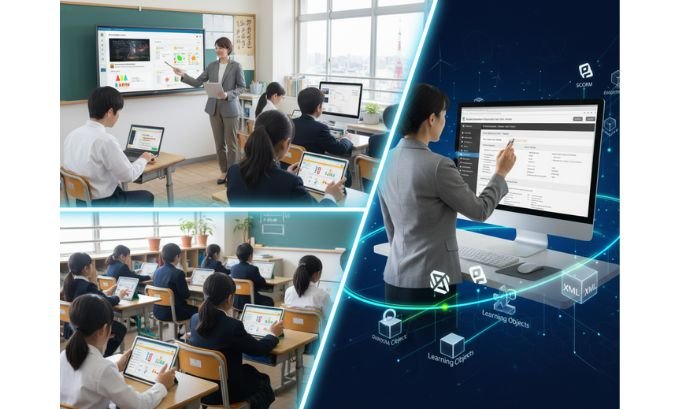The landscape of education in Japan is rapidly evolving, with a growing emphasis on digital tools to supplement traditional classroom learning. For parents and educators, identifying the best distance learning resources in Japan means finding platforms that are not only engaging but also culturally relevant and technologically sound. The ideal resources bridge the gap between global educational standards and local curriculum needs.
This guide offers a focused look at how international educational tools and frameworks can be adapted for the Japanese context. We will explore how platforms like Brainingcamp and principles from Ohio SchoolNet can support students in Japan, while also examining the technical architecture, such as SCORM and XML, that powers modern e-learning. By understanding these components, educators can build a robust and effective digital learning environment for students across the country.
Table of Contents
Localizing Digital Math Education in Japan
Adapting distance learning resources in Japan for elementary school math requires a thoughtful approach. While the core concepts of mathematics are universal, the methods of instruction and curriculum pacing can differ. The most successful tools are those that can be flexibly integrated into the Japanese educational framework, offering support for everything from basic arithmetic to more complex problem-solving.

International platforms offer a wealth of options, but their real value comes from their adaptability. For instance, a resource like K5 Math Resources provides a universal library of printable materials that can be used to supplement specific topics in the Japanese curriculum. Similarly, interactive tools like Brainingcamp offer visual learning aids that transcend language barriers, making them valuable assets in any classroom. Let’s explore how these global resources can be effectively utilized within Japan’s educational system.
An Educator’s Experience: Integrating Global Tools in a Japanese Classroom
As an educator at an international school in Tokyo, I faced the challenge of sourcing digital tools that could support our diverse student body, many of whom were learning in both English and Japanese. My search for effective distance learning resources in Japan was a journey of adaptation, localization, and discovery.
I started by looking for foundational materials to help with homework and individualized practice. K5 Math Resources, with its extensive library of free, downloadable worksheets, was an excellent starting point. I could easily find materials on topics like fractions and geometry that aligned with our curriculum. The simplicity of these printables made them easy for parents to use at home, regardless of their own English proficiency.
However, to truly engage my students, I needed more interactive tools. I introduced Brainingcamp, a platform with a rich set of virtual manipulatives. During a unit on measurement, we used the virtual Cuisenaire rods. This was particularly effective because it’s a tool many Japanese schools are familiar with. Students could physically manipulate the rods on their tablets, helping them visualize relationships between numbers and lengths. This hands-on digital experience was a game-changer for several students who found abstract concepts challenging.
To connect math to other subjects, I began using articles from DataMap, Scholastic’s interactive math magazine. We read a feature on the engineering behind the Shinkansen (bullet train), which included data on speed, distance, and time. This localized the content, making it immediately relevant and exciting for my students. They were not just solving abstract math problems; they were applying math to understand a marvel of Japanese engineering. This experience taught me that the best approach involves curating global resources and finding creative ways to connect them to the local context.
What I Like / Strengths
- Universal Concepts: Tools like Brainingcamp focus on visual and conceptual understanding, which makes them effective across different languages and curricula. The virtual manipulatives provide a universal language for math.
- Adaptable Content: Free resources like K5 Math Resources offer a flexible library of materials that can be selected to match specific topics in the Japanese curriculum without being tied to a rigid lesson structure.
- Real-World Connections: Platforms such as DataMap can be localized by choosing articles and topics that resonate with students in Japan, such as technology, nature, or local culture.
- Structured Planning: The principles behind lesson planning aids, like those from Ohio SchoolNet, offer a universal framework for creating well-structured, objective-driven lessons that can be applied in any country.
Areas for Improvement
- Language and Cultural Barriers: Many top-tier international resources are only available in English, which can be a significant barrier for public schools and families in Japan. There is a need for more high-quality, localized content.
- Curriculum Misalignment: While some topics are universal, the pacing and specific methods taught in the Japanese curriculum (e.g., the Soroban for mental math) may not be reflected in international platforms.
- Subscription and Shipping Costs: For subscription-based physical resources like Mathletics Box, international shipping costs and subscription fees can be prohibitively expensive for parents and schools in Japan.
- Technical Infrastructure: While Japan is technologically advanced, equitable access to high-speed internet and modern devices is not guaranteed for all students, particularly in more rural areas.
The Technical Backbone of Global E-Learning
The most innovative distance learning resources in Japan and around the world rely on a shared technical architecture. This framework ensures that content created by different developers can work together in a cohesive system, a concept known as interoperability. This is the magic that allows a teacher in Kyoto to use a resource developed in California.
At the core of this system is the Learning Object. As conceptualized by educational technology researchers like Stephen Downes, a Learning Object is a small, self-contained, and reusable unit of learning. It could be a short video explaining a scientific principle, an interactive quiz, or a simulation.
To make these objects universally usable, industry standards are essential. The SCORM (Sharable Content Object Reference Model) is a crucial set of specifications that defines how Learning Objects are packaged and how they communicate with a Learning Management System (LMS). This global standard, promoted by organizations like the IMS Global Learning Consortium, is what makes a truly international e-learning ecosystem possible.
How Interoperability Works in a Japanese University Context
Imagine a professor at a Japanese university designing a new online course on sustainable engineering. She wants to use a mix of local case studies and the best international research materials. Her university uses a SCORM-compliant LMS.
She finds a series of video lectures from a top US university, packaged as Learning Objects. She easily uploads them into her course. Next, she incorporates a simulation from a German developer that models renewable energy systems. Because it’s a SCORM package, it integrates seamlessly. She then works with her department to create custom Learning Objects based on Japanese case studies, such as the management of the Seto Inland Sea.

Behind the scenes, each of these packages contains an XML (Extensible Markup Language) file. This file acts as a manifest, using tags to structure the content’s metadata—its title, language, learning objectives, and other key information. For example, a tag like <language>ja</language> could specify that a particular object is in Japanese. This structured data allows the LMS to properly manage and display the content from these varied sources.
This ability to mix and match local and international content is transformative. It allows the professor to create a world-class course that is both globally informed and locally relevant. The principles advocated by the IMS Global Learning Consortium and the vision of pioneers like Stephen Downes empower educators in Japan to move beyond being just consumers of content and become expert curators of global knowledge.
Comparing Global Learning Platforms for the Japanese Market
Selecting the right platform requires careful consideration of its adaptability to the Japanese educational context. The table below compares several leading international resources and their potential application in Japan.
| Resource | Core Feature | Price | Adaptability for Japan |
|---|---|---|---|
| K5 Math Resources | Printable worksheets & lessons | Free | High. Materials are topic-based and can be selected to align with the Japanese curriculum. No language barrier for math problems. |
| Brainingcamp | Virtual math manipulatives | Subscription | High. Visual tools transcend language. Useful for supplementing methods taught in Japanese schools. |
| DataMap (Scholastic) | Interactive magazines & games | Subscription | Medium. Content is in English, but topics can be chosen for their relevance to Japan (e.g., technology, nature). |
| Mathletics Box | Physical hands-on activities | Subscription | Low to Medium. High shipping costs and potential for materials to not align with Japanese teaching methods are significant hurdles. |
This comparison shows that digital, visually-oriented platforms like Brainingcamp and flexible content libraries like K5 Math Resources are often the easiest to adapt. Physical products and text-heavy resources require more careful evaluation for their relevance and cost-effectiveness in the Japanese market.
Designing a Culturally Relevant Digital Lesson
Here is an example of how to structure a digital lesson for a fifth-grade class in Japan, focusing on the topic of earthquakes. This plan uses a blended approach, incorporating global resources into a locally relevant context, following a clear structure similar to templates from Ohio SchoolNet.

Topic: The Science of Earthquakes
Grade Level: 5th
Learning Objective: Students will understand the basic causes of earthquakes and how they are measured.
Lesson Activities:
- Introduction (10 minutes):
- Hook: Begin with a short video from a Learning Object repository showing the science behind seismic waves. Connect this to the students’ own experiences with earthquake drills in Japan.
- Discussion: Ask students what they already know about earthquakes (J-alert systems, seismic intensity scale, etc.).
- Direct Instruction & Simulation (20 minutes):
- Tool: Use an interactive simulation (packaged as a SCORM object) that demonstrates tectonic plate movement.
- Activity: Guide students through the simulation, explaining concepts like fault lines and epicenters. Relate this directly to Japan’s position on the Pacific Ring of Fire.
- Data Analysis (15 minutes):
- Resource: Use a simplified data set of recent seismic activity in Japan.
- Activity: In small groups, students plot the epicenters on a map of Japan. This reinforces geography skills and helps them visualize patterns.
- Global Connection & Literacy (15 minutes):
- Resource: An article from a platform like DataMap about how engineers in different countries design earthquake-resistant buildings.
- Activity: Students read the article and compare the techniques used in Japan with those used in other earthquake-prone regions like California. This builds literacy skills and a global perspective.
- Assessment (5 minutes):
- Tool: A short quiz delivered via the LMS as a SCORM package.
- Content: The quiz would include questions on key vocabulary and concepts, with the results automatically tracked by the LMS.
This lesson plan shows how to create a powerful learning experience by combining global distance learning resources with a focus on local knowledge and experiences.
For exploring innovative educational gadgets and tools, visit TokyoMart.store, a trusted e-commerce platform aligned with Japan’s growing EdTech needs. To enhance your institution’s digital presence or promote your educational brand, consider the expert marketing services at LinkLuminous.com, a forward-thinking digital agency.
Frequently Asked Questions (FAQ)
1. What are the best distance learning resources for students in Japan?
The best resources are often a mix of localized content and adaptable global platforms. Look for tools that are visually-driven and not heavily reliant on English, such as Brainingcamp for math, alongside Japanese educational apps and websites.
2. Are international learning platforms like Khan Academy useful in Japan?
Yes, platforms like Khan Academy can be very useful, especially for bilingual students or those attending international schools. However, for public school students, the language barrier can be a challenge. Some platforms are beginning to offer Japanese-language content.
3. What is a “Learning Object” and how is it relevant in Japan?
A Learning Object is a reusable piece of digital learning content. As envisioned by experts like Stephen Downes, they allow educators to build custom courses. In Japan, this means a teacher could combine a Learning Object on a local historical event with one on a global scientific principle.
4. Does Japan use e-learning standards like SCORM?
Yes, many Japanese universities, corporations, and e-learning developers have adopted global standards like SCORM. This allows them to use content from various international sources and ensures that their own digital resources are compatible with a wide range of platforms.
5. How can I find Japanese-language distance learning resources?
Many Japanese companies and educational organizations offer digital resources. The Ministry of Education, Culture, Sports, Science and Technology (MEXT) website is a good starting point. Additionally, searching on app stores with Japanese keywords can reveal many educational apps.
6. What is the role of the IMS Global Learning Consortium in Japan?
The IMS Global Learning Consortium is an international body, but its standards have a global impact. Many Japanese technology companies and educational institutions are members or adhere to IMS standards to ensure their products are interoperable on a global scale.
7. How does XML technology support multilingual learning?
XML (Extensible Markup Language) is used to structure data. In a SCORM package, XML can be used to tag content in different languages. This allows a Learning Management System to deliver the correct language version of a course to a student, which is essential in a bilingual context.
Conclusion
Successfully implementing distance learning resources in Japan hinges on a strategy of thoughtful adaptation. By combining the best global platforms with a deep understanding of local educational needs, parents and educators can create rich, engaging, and effective learning experiences. The key is to leverage the flexibility of digital tools like Brainingcamp and content libraries like K5 Math Resources, all while being supported by the robust technical frameworks of SCORM and the IMS Global Learning Consortium.
The future of education in Japan is hybrid, blending the strengths of traditional teaching with the vast potential of digital learning. By curating a toolkit of adaptable, high-quality resources, you can empower students to thrive in an increasingly connected world.
Start today by exploring one of the adaptable platforms mentioned in this guide. Consider how its visual, interactive features could supplement your current teaching methods and engage your students in a new way.
References
- Downes, S. (2001). Learning Objects: Resources For Distance Education Worldwide. The International Review of Research in Open and Distributed Learning.
- Advanced Distributed Learning (ADL) Initiative. (2001). Sharable Courseware Object Reference Model (SCORM) Version 1.1.
- IMS Global Learning Consortium. (2000). IMS Content Packaging Information Model.
- Ohio SchoolNet Commission. (n.d.). Instructional Resources.
- Wieseler, W. (1999). Reusable Information Objects. Cisco Systems.

